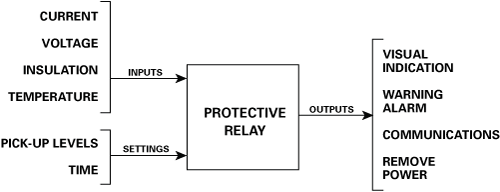
For those of you wondering, what is a protection relay? Littelfuse has the answer. A protection relay is a smart device that receives inputs, compares them to set points, and provides outputs. Inputs can be current, voltage, resistance, or temperature. Outputs can include visual feedback in the form of indicator lights and/or an alphanumeric display, communications, control warnings, alarms, and turning power off and on. A diagram answering the question what is a protection relay is shown below.

FIGURE 1
Protection relays can be either electromechanical or electronic/microprocessor-based. Electromechanical relays are an obsolete technology consisting of mechanical parts that require routine calibration to stay within intended tolerances. Microprocessor or electronic relays use digital technology to provide quick, reliable, accurate, and repeatable outputs. Using an electronic or microprocessor-based relay instead of an electromechanical design provides numerous advantages including improved accuracy, additional functions, reduced maintenance, smaller space requirements and lifecycle costs.
Inputs
A relay needs information from the system to make a decision. These inputs can be collected in a variety of ways. In some cases, the wires in the field can be connected directly to the relay. In other applications, additional devices are needed to convert the measured parameters to a format that the relay can process. These additional devices can be current transformers, potential transformers, tension couplers, RTDs or other devices.
Settings
Many protection relays have adjustable settings. The user programs settings (pick-up levels) that allow the relay to make a decision. The relay compares the inputs to these settings and responds accordingly.
Processes
Once the inputs are connected and the settings are programmed, the relay compares these values and makes a decision. Depending on the need, different types of relays are available for different functions.
Outputs
The relay has several ways of communicating that a decision has been made. Typically the relay will operate a switch (relay contact) to indicate that an input has surpassed a setting, or the relay can provide notification through visual feedback such as a meter or LED. One advantage of electronic or microprocessor relays is an ability to communicate with a network or a PLC.
As an example, a thermostat can be evaluated using the diagram in Figure 1. The input that is measured is temperature and the protection relay input device is the temperature sensor. The user sets the desired temperature setting (pick-up level). The relay measures the existing air temperature and compares it to the setting. The outputs can be used to provide controls (turning an air conditioner or furnace on or off) and visual indication on the thermostat display.
Are you still wondering, what is a protection relay? Find more information on protective relays now.